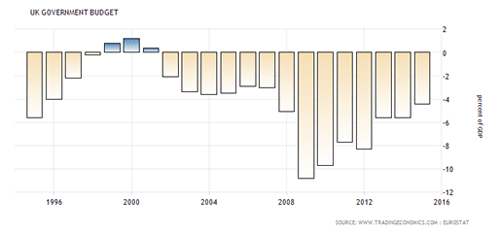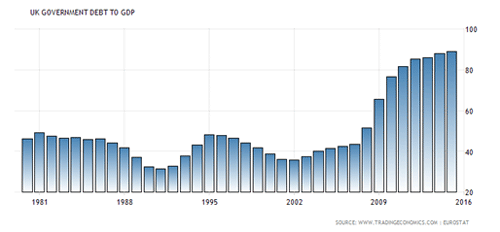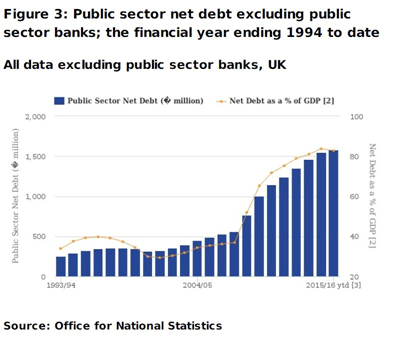This article is probably going to polarise opinion. You’re going to either accuse me of being a “debt fetishist” and “doom monger”. Or you’re going to agree that since 2008, the world’s financial system has become even more burdened by debt – and thus, a lot more dangerous. So dangerous, in fact, that I’m beginning to suspect the only way out is a complete system “reset”.
The argument I’m going to make is simple:
Negative interest rates have made the global debt problem worse. The worse the debt problem gets, the more dangerous banks and government bonds are. The “endgame” for the whole process is a bear market in bonds, a paper currency crash (devaluation/inflation), and a bull market in precious metals and tangible goods — a global financial reboot.
A reboot is what you do when a computer crashes. The global financial economy isn’t a computer. It’s even more complex. It’s become so complex, and so compromised by an addiction to credit and debt, it can’t produce growth anymore. This is what negative interest rates and currency devaluation are all about – last ditch efforts by confused academics to return to normal. It won’t work.
Fed normalisation and Haldane confusion
This is the perfect day to make the argument. It’s the perfect day because the US dollar is up after the minutes of the April Federal Open Market Committee were released. Those minutes strongly suggested that unless US economic data was terrible in May, the Fed would be strongly inclined to lift US interest rates when it meets on 14 and 15 June.
The scenario I’m describing here is where the opposite happens – US rates follow those in Japan and parts of Europe and go negative. If that were to happen, it could unleash a chain reaction of moves in financial markets that you’d want to be well aware of (and prepared for) right now. But I realise it’s a lot to digest, so bear with me.
The other reason today is a great day to explore the issue (even if my thinking on these matters is still a little unclear) is because of what Andy Haldane said yesterday in New York City. Haldane admitted what I have long suspected: that many central bankers are clueless but disguise it by using big words.
He admitted that though he was financially literate, he was not “able to make the remotest sense of pensions.” And it’s not just him. Haldane said that, “Conversations with countless experts and independent financial advisers have confirmed for me only one thing – that they have no clue either.”
Remember this is the man who, late last year, floated the idea of negative interest rates as a way to make monetary policy more effective. Perhaps he could have spared a thought for pensioners then. People on fixed incomes don’t exactly benefit from low interest rates. But then, if you had trouble understanding pensions, you might have trouble understanding why negative rates are so bad for savers.
It’s not like Haldane is stupid. He knows that complex rules are a “desperately poor basis for sound financial planning.” When the chancellor changes the rules all the time, it’s hard to plan for your future. It wasn’t supposed to be that way when the government passed “pensions freedom” last year.
Haldane pointed out that, “[P]ension freedoms have given individuals more control over how to invest their retirement funds than ever before.” But how to invest has never been harder. Interest rates are at historic lows. The laws change. And as Haldane said, “More of the risk associated with financial decisions is these days being shouldered, not by the state or companies, but by individuals.”
I don’t know about you, but I don’t have any problem with the last part. I’m fine being responsible for my own financial decisions. If you’re like me, you’d rather take your financial affairs into your own hands than trust someone else with them. It’s riskier to trust someone else with your retirement than to look after it yourself.
But he does make an important point: if you don’t know what the law is, or what the potential impact of expanding debt and low interest rates are, then you won’t know how to plan. Your financial future will be at risk through no fault of your own. If you don’t have a plan, you have a problem.
$9 trillion in negative yielding bonds
First let me just challenge the idea that interest rates anywhere – even in the US – are headed back to normal levels. If it were legal, I’d say they can’t. But it’s not legal. And anything can happen. So let me just say this: enormous government debt-to-GDP levels make a large increase in interest rates this year highly unlikely – absent some enormous unexpected shock (war/terrorism/cataclysm).
Did you know that over $9.4 trillion in bonds were negative yielding as of early May of this year? That’s a 67% increase from last year. That means governments are taking advantage of ultra-low interest rates to increase their borrowing. Fully 23.6% of the total global fixed income market has bonds with negative yields.
As Tim pointed out last year in The War on Cash, the big risk of negative yields is that they destabilise the entire banking system. Think about it. If the banks charge you money to keep money in the bank, why would you? The answer: you probably wouldn’t!
Banks haven’t imposed negative rates yet. But because they earn so little interest themselves in a low-rate world, they may soon impose negative rates on customers. If they do that, banks would lose the perception as a safe place to keep your money.
And it wouldn’t just be the banks. Government bonds themselves would likely lose the perception that they’re risk free. The “risk free” rate of return on government bonds has long been considered the margin of safety for investors. If you can’t do better than the “risk free” return in bonds, then don’t risk your money in the share market – unless you’re willing to accept much higher risk for the chance of much larger returns.
But don’t let me get too far afield. My argument to you right now is this: there is very little real growth in the US economy. That means the Fed won’t “normalise” rates any time soon. In fact, I think the opposite is true. I believe that it’s only a matter of time before the Fed joins the Bank of Japan and the European Central Bank and imposes negative rates.
When that happens it will kick off a crisis in the capital markets, the likes of which we haven’t seen since the 1970s. The effects could be similar. Your best investment strategy to prepare may be to go “back to the future” and prepare for massive inflation.
Britain’s public pension time bomb
Before you shout at me that debt doesn’t matter and we owe it to ourselves, please just acknowledge what’s happened in Britain since 2005. UK national debt was £500 billion in 2005. It was just 38% of GDP and all was right in the realm.
Then came the end of the financial world as we know it in 2008. In a few short years, the national debt would double to £1 trillion. By 2009 – after the government bailed out the banks – the annual deficit as a percentage of GDP was over 10%. By 2010, the government debt-to-GDP level hit nearly 80% – twice what it had been just five years before.
You can see the jump in the three charts below. You may think the government did what it had to do. You may think it was right that Labour increased spending even as the economy ground to a halt. And if you’re a Tory, maybe you have no problem with the £555 billion increase in debt under Chancellor George Osborne’s watch. I’m not asking you take a political position here. I’m just establishing the facts.
The facts paint an ugly picture. UK public sector debt is now over £1.6 trillion. It’s not Japan-size yet. But unless GDP growth picks up, the debt-to-GDP ratio will remain ugly. It will be hard for this chancellor – or any chancellor – to reduce the deficit. Your taxes will pay interest on money already borrowed. And the borrowing will continue.
Here’s the bad news: the chart above doesn’t even tell the full picture of how bad Britain’s public debt problem could get.
If you take all of Britain’s public sector debts and liabilities – including unfunded public pensions – the net liability of the UK Government is closer to £1.85 trillion. This figure is taken from the Office for Budget Responsibility. It’s called the Whole of Governments Accounts (WGA). It’s the broadest measure of the UK government’s long-term liabilities and assets.
This figure is different – and larger – than the figure from the Office for National Statistics (ONS). The WGA bases its calculations on modern day account principles. It treats the UK government as if it were a going concern. You can argue whether it should do that. But the WGA figure shows that the UK’s broadest measure of government debt is already near 100%.
I’m not going to yammer on about debt. Odds are if you’re still reading this you agree with the point I’m making: debt is a tax on future generations. It’s a huge burden future generations have to repay. And we’ve been racking it up in the misguided sense that we “owe it to ourselves” or that governments should borrow heavily in times of crisis.
Maybe it worked during the Great Depression or World War II, when economist John Maynard Keynes first recommended deficit spending. The government debt-to-GDP ratio went close 245% by the time the war ended. But then it went down. Spending went down. Britain paid the debt back.
But now, no serious economist would argue that governments can safely have debt-to-GDP ratios over 100% and expect nothing to happen. It’s probably not moral to run such large debts. And it’s certainly not normal. But what will happen next?
Category: Market updates




